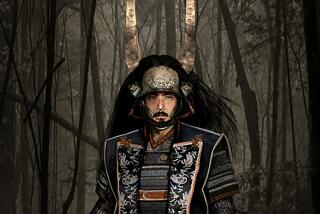DANCE REVIEWS : BUGAKU RITUAL AT JAPAN AMERICA
- Share via
Over the past decade, Los Angeles audiences have had major opportunities to sample the ancient Japanese ceremonial dance idiom called Bugaku. Each time the unyielding formality of the dancing--the emphasis upon repetitions, unisons, spatial polarities--linked this 1,200-year-old ritual form to Western minimalist experimentation of our own era.
Visits by the Osaka Garyo-kai in 1978 and an ensemble from the Kasuga Shrine in 1984 suggested the religious context of Bugaku, but the performance Sunday afternoon at the Japan America Theatre by musicians and dancers of the Imperial Court evoked Bugaku’s function as entertainment for royalty.
The sense of concentrated splendor proved spectacular, with one set of richly ornamented orange costumes followed by different orange robes that managed to be more sumptuous, succeeded by a display of yet another orange--this one of even greater iridescence.
The music again achieved enormous weight through the sustained unearthly blare of exotic reed instruments and the cyclical accents of plucked strings and percussion--mostly treble drums here, in the absence of gigantic Dadaiko drum-units like the ones used in the Kasuga Shrine performances in the same theater two years ago.
During the instrumental and vocal selections, the 15 musicians performed inside a raised, railed enclosure at center stage. For the dances, they moved to areas outside the railings and the dancers worked within the wooden frames.
Two dance solos of ritual homage, a quartet of invocation and a character solo all established, powerful martial imagery. In the “Enbu” solos, both Goro Ikebe and Hideaki Bunno solemnly executed a stately gestural presentation of their weapons, after which they slowly swung them in circles in front of and above their heads.
In “Bairo,” the four warriors danced with swords, shields and lances, transforming threatening battle stances into near-abstract movement design through mirror synchrony and repetition.
In “Ranryo-o,” Ikebe appeared in a grotesque mask as a prince disguising his features to frighten the enemy. Taking wide squat-strides and deliberate yet quick bounding steps, he traced wide arcs around him with his pointed fingers and short, gilded wand. As an example of a dancer commanding space (rather than just occupying it), he was a revelation.
More to Read
The biggest entertainment stories
Get our big stories about Hollywood, film, television, music, arts, culture and more right in your inbox as soon as they publish.
You may occasionally receive promotional content from the Los Angeles Times.










